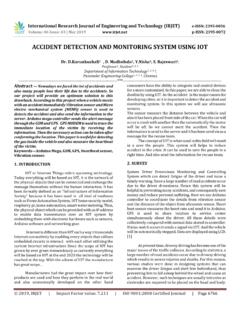Transcription of AUTOMATIC STREET LIGHT CONTROL SYSTEM
1 AUTOMATIC STREET LIGHT CONTROL SYSTEM (MINOR PROJECT) ABSTRACT AUTOMATIC STREET LIGHT CONTROL SYSTEM is a simple yet powerful concept, which uses transistor as a switch. By using this SYSTEM manual works are 100% removed. It automatically switches ON lights when the sunlight goes below the visible region of our eyes. This is done by a sensor called LIGHT Dependant Resistor (LDR) which senses the LIGHT actually like our eyes. It automatically switches OFF lights whenever the sunlight comes, visible to our eyes. By using this SYSTEM energy consumption is also reduced because nowadays the manually operated STREET lights are not switched off even the sunlight comes and also switched on earlier before sunset.
2 In this project, no need of manual operation like ON time and OFF time setting. This project clearly demonstrates the working of transistor in saturation region and cut-off region. The working of relay is also known. 1. INTRODUCTION- STREET LIGHT controllers are smarter versions of the mechanical or electronic timers previously used for STREET LIGHT ON-OFF operation. They come with energy conservation options like twilight saving, staggering or dimming. Also many STREET LIGHT controllers come with an astronomical clock for a particular location or a global positioning SYSTEM (GPS) connection to give the best ON-OFF time and energy saving.
3 AUTOMATIC STREET LIGHT CONTROL SYSTEM is a simple and powerful concept, which uses transistor as a switch to switch ON and OFF the STREET LIGHT automatically. By using this SYSTEM manual works are removed. It automatically switches ON lights when the sunlight goes below the visible region of our eyes. It automatically switches OFF lights under illumination by sunlight. This is done by a sensor called LIGHT Dependant Resistor (LDR) which senses the LIGHT actually like our eyes By using this SYSTEM energy consumption is also reduced because now-a-days the manually operated STREET lights are not switched off properly even the sunlight comes and also not switched on earlier before sunset.
4 In sunny and rainy days, ON time and OFF time differ significantly which is one of the major disadvantage of using timer circuits or manual . This project exploits the working of a transistor in saturation region and cut-off region to switch ON and switch OFF the lights at appropriate time with the help of an electromagnetically operated switch. A STREET LIGHT , lamppost, STREET lamp, LIGHT standard, or lamp standard is a raised source of LIGHT on the edge of a road or walkway, which is turned on or lit at a certain time every night.
5 Modern lamps may also have LIGHT -sensitive photocells to turn them on at dusk, off at dawn, or activate automatically in dark weather. In older lighting this function would have been performed with the aid of a solar dial. It is not uncommon for STREET lights to be on poles which have wires strung between them, or mounted on utility poles. This project exploits the working of a transistor in saturation region and cut-off region to switch ON and switch OFF the lights at appropriate time with the help of an electromagnetically operated switch AUTOMATIC Streetlight needs no manual operation of switching ON and OFF.
6 The SYSTEM itself detects whether there is need for LIGHT or not. When darkness rises to a certain value 2. BASIC PRINCIPLE- The AUTOMATIC streetlight CONTROL SYSTEM operates on 12 V DC supply. The AUTOMATIC streetlight controller has a photoconductive device whose resistance changes proportional to the extent of illumination, which switches ON or OFF the LED with the use of transistor as a switch. LIGHT dependent resistor, a photoconductive device has been used as the transducer to convert LIGHT energy into electrical energy.
7 The central dogma of the circuit is that the change in voltage drop across the LIGHT dependent resistor on illumination or darkness switches the transistor between cut-off region or saturation region and switches OFF or ON the LEDAs we know property of LDR that during the time of day resistance is low therefore voltage at the inverting input ( IE pin 2) is higher than the voltage at the non-inverting input (pin3) hence the output at the pin6 is low so the transistor goes into the cut off state which means LED or bulb will not glow.
8 3. CIRCUIT DIAGRAM Figure Circuit diagram of AUTOMATIC STREET LIGHT controller. 4. LIST OF COMPONENTS- PARTS RANGE QUANTITY 1. LDR 1 2. TRANSISTOR BC -547 NPN 2 3. RESISTOR 1K, 330 ohm 3 4. LED 1 5. PCB 1 6. POWER SUPPLY 6V OR 9V 1 5. SPECIFICATION OF COMPONENTS- LDR ( LIGHT DEPENDENT RESISTER) LDRs or LIGHT Dependent Resistors are very useful especially in LIGHT /dark sensor circuits. Normally the resistance of an LDR is very high, sometimes as high as 1000 000 ohms, but when they are illuminated with LIGHT resistance drops dramatically.
9 When the LIGHT level is low the resistance of the LDR is high. This prevents current from flowing to the base of the transistors. Consequently the LED does not LIGHT . TRANSISTORS BC547 is an NPN bi-pola junction transistor. A transistor, stands for transfer or resistance commonly used to amplify current. A small current at its base controls a larger current at collector & emitter terminals. BC547 is mainly used for amplification and switching purposes. It has a maximum current gain of 800. Its equivalent transist The transistor terminals require a fixed DC voltage to operate in the desired region of its characteristic curves.
10 This is known as the biasing. For amplification applications, the transistor is biased such that it is partly on for all input conditions. The input signal at base is amplified and taken at the emitter. BC547 is used in common emitter configuration for amplifiers. The voltage divider is the commonly used biasing mode. For switching applications, transistor is biased so that it remains fully on if there is a signal at its base. In the absence of base signal, it gets completely off. RESISTORS- Resistor is an electrical component that reduces the electric current.







